Beyond the mirror
Beyond the mirror
The manifest of Total Reality
by Dario de Judicibus
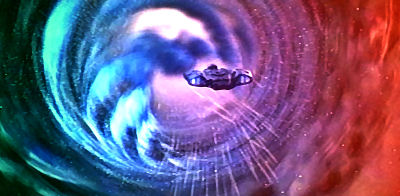
Often, in science fiction novels, futuristic spaceships and intrepid pioneers cross invisible cracks in the time-space continuum to cross interstellar distances in a short time, faster than the speed of light. It does not matter if they are called stargates or wormholes, if we are talking of hyperspace, fifth dimension or warp speed; the bottom line is always the same: a shortcut to other worlds.
Nowadays this shortcut does exist and really takes us into a very different world from what we are used to: this shortcut is called browser and the world in which we can enter is called the World Wide Web. Initially intended as a simple way to share and connect with each other documents mostly related to scientific research, today the web has evolved to the point of being plenty of real parallel universes as virtual worlds and social networks.
Two separate worlds
Facebook is sometimes considered one of the largest countries in the world and Second Life and other virtual worlds are regarded as real parallel realities in which traditional social rules do not seem to be valid anymore and everybody often behaves in completely different ways with respect to how they behave in the real world. True or not true, the web is to a certain sense an alien but also extremely human world, and although the real world is often seen in contrast to the virtual one — as if the first be made of concrete things and the second does not — those who frequently visit these worlds know that there is really nothing virtual in the various digital environments.
In fact, contents are not virtual at all, because they reflect the thoughts of those who wrote them if we are talking about books and articles; because they show real events and situations that actually occurred if we are talking about photos; because they tell stories of people and things if we are talking about videos; because they induce perceptions and feelings if we are sharing music, drawings, poems, or other forms of art. Neither are virtual the devices that allow us to access them, whether they are sophisticated computers or just smartphones, but above all they are not virtual because the people who created these contents and the motivations that led to their creation are absolutely real.
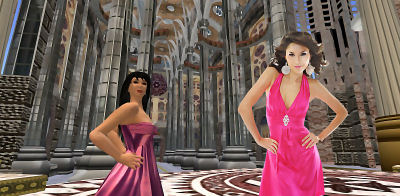
The web may indeed be one of the most impressive realities of our age and the fact that we cannot touch it directly, that is, we cannot cross the mirror as Alice, does not mean that it is not absolutely real. In fact it is so real that armies of philosophers, sociologists, anthropologists, and psychologists have been studying it for years and are digging deeper into it to understand how it is affecting individuals, subcultures, and societies, and how in turn it is influenced by them.
Yet this wonderful reality that can make us walk the streets of New Delhi without moving from home, get into a museum of a city and then go through a door and find ourselves in a gallery of another town, space travel between the planets of the solar system and at the same time share online such experience with a never-met Buenos Aires’ friend or a man we met while vacationing in Tokyo, met again on the web years later, remains inexorably beyond our direct sensory experience, such as when we observe dolphins play or when we hear the singing of whales on the high seas, but we are always painfully aware that we do not really belong to their world.
On the contrary, the real world is annoyingly anchored to physics and gravity: rarely a click can solve a problem and even the most sophisticated vehicle requires more than just pressing few buttons to be driven. The reality is difficult, forcing us to move from our chairs to do anything; it gives us little information and we never seem to have on hand what we need. The reality is slow and does not allow us to quickly teleport from place to place, to analyze the same information under several points of view, to connect within seconds data, information and concepts from very different sources.
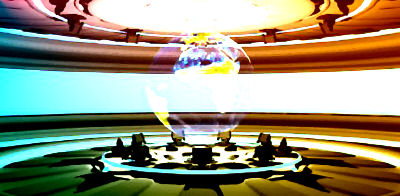
In practice, we are facing two separate worlds, in a schizophrenic experience of use in which we live equally separate lives. Yet these two worlds are more and more connected, and we feel more and more the need to be able to keep one foot in each of them at any time. The development of increasingly sophisticated phones, netbooks, ultrabooks, every kind and form of tablets, already allows us to always have the web close at hand, even if the true leap in quality there will be only when at least all urban centers be equipped with free wireless networks to stay permanently connected.
Always connected
So, is this the scenario that awaits us in the near future, this being always connected and at the same time separated by a thin sheet of glass from that wonderful world with no apparent boundaries, or is there anything more? In fact, having the web always under the fingertips, being always connected to friends, personal data, such a continuous exchanging, sending, receiving and sharing information is just the tip of the iceberg that has not yet been revealed to most. The future is preparing us more surprises, surprises that until a few years ago we could only see in some sci-fi movie, just like the iPad is strongly reminiscent of those futuristic devices that crew members of the Enterprise always had in the hands in all the episodes of the Star Trek saga.
The necessary technology already exists and innovation is often not so much in developing new ideas, but rather integrating many small existing pieces of technology into a single coherent mosaic. Just as an orchestra is not simply a sum of instruments but it is itself a wonderful new instrument, so all of these pieces, together, assume a new identity, a new dimension that will allow us to overcome the current barrier between the two worlds and allow us to finally cross the mirror.
I called this scenario Total Reality, because this is what it actually will be: a unique and continuous experience of what both worlds, the real and the virtual one, may provide in an overlapping not only based on sensations that stimulate all the senses, but also on actions, events, communications, through a network where even the simplest objects, whether real or virtual, will not only be connected but will interact with each other.
The basic idea is to transform reality as we know it in a single immense interface to the virtual world on the one hand, to use the web as a hyperspace able to connect instantly (or almost) any element of the real world, be it human or inanimate, on the other hand. At last the web will not only be a technological infrastructure but it will acquire the characteristics of a biological system, not just because it will have each individual integrated in the system itself, but also because each object will have potentially a certain level of “intelligence”, a certain capacity to interact and even autonomously make its own decisions.
A matter of senses
Which features should have objects to be part of this new total reality and how will we interact with them? Let us first consider this second point. The basic idea is to keep our existing natural interactions with everyday objects: you sit on a chair, you open or close a door or a window, you look at a picture, you read a book. All these actions will not change but they will acquire a different meaning.
When we sit down or we enter a room by opening a door, innanimate objects will recognize us and, knowing what our needs are, send signals in the network that will change some data. These changes will be incorporated by other objects which in turn will change their state based on this information.
Today, if we enter a room equipped with a motion sensor we can set it up to automatically switch on the light. Tomorrow the light intensity or which lights should be switched on and which not will depend on whether the room knows who has entered and will adapt certain choices to the specific individual and to his/her wishes. For example, if a certain person is photophobic, the intensity of the light will still be kept low.
For this to happen, it is necessary that each object has some logic (intelligent), it is equipped with control tools to measure performance and be managed (instrumented), it is connected to the network and thus in fact to any other object that in turn is connected to the web (interconnected), and especially it is equipped with a number of sensors (aware). This last point is particularly important in the interaction with other objects, especially with humans, because intelligence is of little use without senses.
A computer does what we tell it to do. It does not take the initiative because it is not conscious of the environment in which it is located. Not so with a human being. A person adapts his/her decisions to the situation in which he/she is located and he/she does that by using senses. Think of a television, turned on by a child, that decides independently which programs are suitable for a minor and which are not. Of course, a parent should always have the option to override that choice, but from a perspective that is protective with respect the child, it is a reasonable choice. To do so, however, not only must the TV have logic and rules, it must also be able to recognize who is in front of it.
However, we are not talking about transforming our appliances into sophisticated robots. Nature teaches us that often you can get excellent results with surprisingly simple approaches. For example, insects do not use complex functions localized in the brain to coordinate the movements of the legs of varied terrain, but sensors and reaction mechanisms localized in the paws themselves. These mechanisms are so efficient that the insect is able to move even when the brain is damaged. In practice, the coordination between the various legs is not centrally but locally managed. These systems are so efficient that scientists are replicating them in robots with legs whose aim is to explore other planets and moons so far away that we cannot rely on an operator’s remote control from Earth.
Other very effective mechanisms are those that allow the coordination of movements within a flock of starlings or a bench of sardines. In all these cases it is not a complex mainframe to manage the movement, but a series of simple but effective local mechanisms. We can imagine the same for total reality. Each object can be equipped with simple rules, a minimal intelligence and one or two sensors. It will not be so much the interaction with the single object to count as the sequence of interactions within an environment. For example, entering a room and sitting down on the couch will cause, the lights to be switched on to allow me to see in the environment without problems, then lights will be lowered and the television will be turned on, and everything will not be the result of a fixed rule but a learned lesson that will be valid for me, since the system knows that at that time I watch the news, but not for another family member who at another time usually sits to read a book.
The interaction will not be then only between humans and objects, but also among objects themselves. Basically, imagine the web as you know it today, remove all devices that you are used to, such as computers, tablets and even smartphones, and leave only a reality consisting of everyday objects, all connected in the web. Every interaction with an object will change some data in the web, each change of data in the web will change the state or behavior of an object, all that based on simple rules in respect of each object, that will lead to highly sophisticated evolutions because of the complexity of the system.
Those who study fractals or chaos theory know how simple rules can give rise to complex behaviors. Who remembers that simple game called LIFE? Few rules could give rise to very complex structures simulating the development of life from generation to generation. The basic idea is the same.
Technology has dramatically changed the way we interact with reality. Today, when we use the term “writing”, we more easily think of a keyboard rather than a pen, yet man has used the stylus for thousands of years and yet it has only been a few decades where keyboards have become mainstream. The moment has now arrived where man no longer has to adapt to the way with which machines are able to interact, but that machines have to now learn the way with which we interact, that is, gestures, voice, touching or moving something, even facial expressions or the tone of voice. Today the algorithms for biometric or voice recognition are greatly improved and can also be integrated in small devices. Also those for the transcription of speech and machine translation are improved, although they are still somewhat primitive and fallacious. It is only a matter of time, however, until we will be able to speak in one language and have a device that translates what we are saying to another idiom in real time to communicate face to face with people from other countries.
Perhaps the greatest obstacle remains that concerning energy. Currently, batteries have to be recharged too often and make any objects self-sufficient from the energetic perspective is not trivial at all. On the other hand it is unthinkable having to worry about recharging dozens if not hundreds of objects with which we have to interact every day. Here too we can learn from Nature, both in terms of energy production, as in the case of artificial leaves for photosynthesis, and on that of energy conservation, an area in which Nature is the teacher. For example, we already have watches that recharge themselves by using movement. The human body itself could recharge some object we wear.
Some concrete examples
That said, what could be some realistic scenarios of use of the total reality in the near future? A few examples…
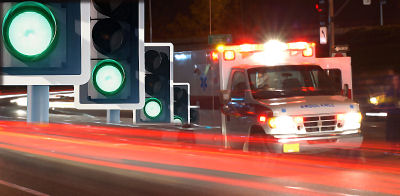
Let us suppose that I feel sick and that the watch on my wrist senses that something is wrong: it could be a heart attack. The device warns me, but I am already on the ground and I cannot give it a confirmation. The watch grasps my worsening health and realizes that I fell, so immediately it calls an ambulance to which it delivers the data of the integrated GPS that has been activated by the emergency, since I was in privacy mode.
The center for medical emergencies receives the request and identifies the nearest available ambulance, all minimizing human intervention. The ambulance in turn receives the request and calculates the shortest path to get where I am right now and informs directly the traffic control center which recommends a variation due to a series of construction along the way. At this point the ambulance accepts the recommended path and requires the traffic control to have a “green wave” along the route in question.
The traffic control center calculates the average speed of the ambulance and prepares the timing of the traffic lights in a timely manner, consistent with other needs: it will, however, control the vehicle to be ready to propose alternatives or changes to ensure a quick arrival in any case. Note that all this happens without the intervention of any human being.
Of course, in the meantime, my smartphone autonomously turns the speaker on and reassures me that the ambulance is coming by using speech synthesis. Needless to say, the watch and the mobile phone are connected to each other, as well as the ambulance and the hospital, which has already received the first data from my watch about my heartbeat and blood pressure values. When the paramedics arrive, the ambulance automatically sends a signal to my smartphone which then unlocks the door to my house because the door lock too is connected to the network. So this chain of networked devices, both in my home and “in the wild”, seamlessly integrate together to make care delivery faster and more efficient.
Such a scenario is not science fiction: it is already possible and in fact the individual technologies already exist and are used in part. What is missing is the integration of the various pieces into a single system that is not specialized for the problem in question, but includes components of every kind designed to meet any possible requirement. That same watch, mobile phone, ambulance, hospital, emergency and traffic control centers, in fact, are each one separately part of dozens of other scenarios that are not related to the one I just described. On the one hand, therefore, the web is not anymore made only of generic computers and intelligent nodes, but also specialized devices designed to provide, receive, and process only some types of data; on the other hand, those same devices can be used in somehow extremely different ways in scenarios that are completely independent.
Some other examples?
I stop in front of a shop window. That shirt is really nice and also the matching pants that the mannequin is wearing are not so bad. The price is also attractive. I decide to enter. This isn’t the first time that I’ve shopped at this store and I am immediately recognized by biometric sensors, since I gave them permission to identify me on a previous visit. The shop immediately associates me to the profile that I keep updated on the web and a salesman comes up to me to tell me that the belt that I wanted but did not find a week before at another store of the same chain is available here. I am still interested in it? I say no, I’ve already purchased a belt elsewhere, but I’d like to see the garment in the window.
The clerk then brings me both the shirt and pants, points to the dressing room and walks away. I try on the outfit, leave the dressing room and I look in the mirror. Not bad, but what if I wanted to change the color of the shirt? I do not want to go back into the dressing room and undress to try another shirt, so I decide to do it in a virtual way. Let us see which colors are available. I make a gesture and a menu appears on the mirror, at the top right corner. I whisper “colors”, since the mirror can perfectly hear me thanks to a directional microphone, so that I do not disturb other customers. A palette of colors immediately is displayed on the right edge of the mirror. I move my hand to select one of them. I keep it on the color for a couple of seconds and the shirt color changes, of course only in the mirror. I start recording with another gesture, I turn around, I move to the side, and then I request to play back the movie: good.
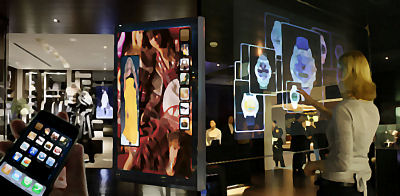
While I am going to choose a second color, the mirror, through a speaker cone that allows only me to hear what it says without disturbing the other customers, recommends a silk tie to match the shirt. I accept and the tie immediately appears at the neck. No, better without, and then I am not keen of ties. Rather… what about belts? I go on like this for about ten minutes, then once I choose the definitive look, I record another movie in which I turn around again to see me in front and behind, and when I’m satisfied I ask the system to send the recorded file to my phone, so that I can share it on a social network.
“What do you think, guys?” I ask on Facebook. A few minutes later, while I am looking through the Men’s Department, I get a few comments. Apparently they liked my choice. I launch an app that I downloaded long ago for this store and I send the code of the suit that I received with the video to the cashier. My profile already contains the data of my credit card, and of course, my home address. I’m being asked to confirm via mobile both payment and delivery: I confirm both and I leave, without having to wait in line for the cashier. By tomorrow at the latest I will receive the outfit at home without additional shipping costs. After all, I am a premium customer and this is one of the benefits, as long asI buy in my city: no shipping costs. How nice to experience e-commerce in a real store!
Obviously one of the pillars of Total Reality is augmented reality. As if in parallel to this world there is another, perfectly overlapped but completely invisible unless we use a magic wand, which shows its contents. It can be a phone with a camera, a pair of special glasses or a transparent screen placed inside a room, usually clear but that, when activated, shows a world otherwise imperceptible that overlaps with the real one. The applications are almost endless. Again, to reduce the need of using personal devices by integrating what we need in the environment in a natural way is what really makes the difference.
Yet another example?
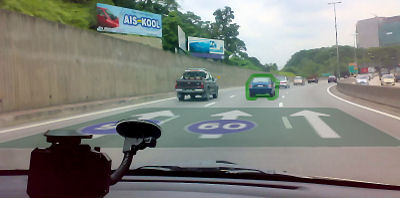
I’m on the highway and I’ve been driving for four hours; of course, I am also pretty tired, so I get too close to the car ahead of mine. Immediately, a voice tells me that I am below the recommended safe distance and the image of the SUV in front of me begins to shine on the front windshield by a light yellow halo that soon goes to orange, because I did not react promptly. So I slow down: the halo goes back to yellow, then green, and at last it disappears. If I got too close, the halo would turn red and a voice with a firm tone would have told me to immediately slow down; it is better not to gamble with certain situations.
I realize it is not best to continue driving, so I decide to stop. I go to the next exit and park in a pretty town in Tuscany. Apparently there is an exhibition of modern art nearby. The restaurant that the navigator recommended to me is still closed, so why not take the opportunity to visit the gallery? There are many paintings and sculptures in the various rooms, but I do not know most of the authors. I realize, however, that alongside the works there are no names or titles or descriptions but only little white squares with funny black hieroglyphics.
The smartphone beeps: it is a message from the exhibition asking me if I want to download the free guide. I accept: a few seconds later, it is installed. A welcome message tells me to load the camera app and aim to the small white squares. So I do it: I get closer to a painting, frame it in the camera which immediately scans the square. First it is surrounded by a blue outline, then the picture comes to life and a series of texts and images begin to appear in the air. The name and photo of the author, the title of the picture, when it was painted and what it represents, even archive footage of the countryside where it was painted… Work by work the whole expo comes to life, talks to me, shows me other pictures, and tells me many stories. I leave the gallery, I’m really glad I visited it: it was a good idea to stop there before dinner.
QR codes are now a reality but soon they will no longer be necessary. In fact, devices will be able to directly recognize objects, as pictures in the previous example, and will provide the requested information. Not only that: info will be different depending on your personal profile. Someone might be interested in the painting technique, others in the story of the painting, still others in information about the portrayed subject.
Socialization
We have seen several scenarios: in some people interact directly with smart objects, in others objects communicate with people or with each other, but… how is the communication between humans impacted by these technologies? I’m not talking about VoIP or Skype: no matter how useful those systems are, they are not conceptually different from a phone or a carrier pigeon. I’m talking about added value and innovation. Let’s see some other scenario.
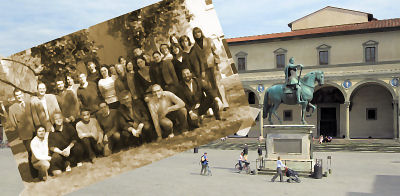
I arrive in Florence and I decide to go to the university where I attended the Faculty of Physics when I was young. By now I have lost any contact with all my old friends, though I found a couple of them on Facebook. I also have the mobile phone number of one of them, but I’ve never called him: he has become a researcher and he is almost always at the Astronomical Observatory in Chile. However my smartphone knows him and has a lot more patience than me: it takes a moment to realize that the faithful electronic companion of my friend, another mobile phone, is in Florence today, and so it warns me. My friend is in town… in San Marco’ Square!
It has been 10 years since we last met! A mere coincidence? Maybe, but if fate gives us an opportunity, we must also be prepared to take it and if it were not for our mobile phones perhaps that would never have happened. A phone call and we are in touch again. We will meet downtown in about an hour to have an ice cream and to talk of past times and, perhaps, even a little bit of the future. Of course, privacy is important, but if we are not doing anything that we wish to keep confidential, why not allow others to get in touch? Life is made up of relationships, but to socialize we must be willing to open up, at least a little bit.
These are just a few examples, but I have no doubt that the future will propose scenarios that are unthinkable at the time but already achievable with current technology. This is Total Reality: real and virtual worlds superimposed, mixed, in a way that will become increasingly difficult to disentangle them, to distinguish them. Being able to communicate, to touch, to test any object at all times, not caring about where it is or who owns it. After all, when we surf the web, we do not care to know whether a certain article in English was written by an Italian and published on an Australian blog hosted by a Japanese server of a Russian company. Does it really matter to know?
A world without borders, not flat, as some would say, but layered, interconnected, intricate and at the same time accessible, fluid, and flexible. A global and local environment, where the common elements facilitate the access to the diversity in a glocalization that is capable of integrating cultures and ideas from several countries without biasing the richness of diversity. In Nature the true value is in fact biodiversity; in society sometimes we think that both to unify and to standardize is valuable. This is certainly true at the infrastructure level, but at the application and semantic layers diversity is the real value.
To deal with what is different stimulates our mind, allows us to develop new concepts that others can in turn take and rework in a process that is not necessarily governed but nevertheless efficient and effective. The real adventure is in the unexpected, the real innovation in the discovery and the true discovery is not the one we plan but what surprises us, what we did not imagine.
A world of objects and people, both real and virtual, based on real names and aliases, and consisting of many pieces of content of any kind, that overlap and are linked in complex patterns regardless of where they were created and who created them. Such a world will have a terrific impact on paradigms consolidated for centuries: on laws, on case law, on the concept of ownership or rights, generating cross geographies with respect to the traditional one, parallel stories with respect the official one, eliminating time and space and acting as a new dimension not only to navigate, but also to live an unprecedented everyday experience, where everyone is somehow maker and creator, with no limits or boundaries.
For example, today we think of ourselves as citizens of specific nations; in future we will consider ourselves part of wider communities that do not think anymore in terms of territories but of values, that is, all people trusting specific values will consider themselves citizen of the same “supernation“.
Too visionary? Let us talk about it in five or six years…
Translation reviewed by Gregory Cifelli — any remaining error is due to the author.




















cinque sei anni forse son pochi… la tecnologia è pronta, non la burocrazia o le infrastrutture…
E tutto sommato, non so se mi piacerebbe essere trovato così facilmente… e l'ambulanza finirebbe la benzina che il pirla di turno s'è scordato di mettere nonostante il sistema lo abbia più volte avvisato con palle lampeggianti rosse e fucsia.
V
Oh, beh, suppongo che non ci sia realtà totale che possa mettere una pezza alla stupidità umana, quando questa ci si mette di mezzo, ma nessuno si sta vendendo tutto ciò come una panacea. Tuttavia la tecnologia può essere davvero un modo per renderci più semplice la vita, finché siamo noi a controllarla. Pensate quanto era difficile una volta telefonare per avvisare casa di un ritardo o di un incidente quando eri per strada: prima dovevi cercare una cabina telefonica, poi sperare che avesse ancora la cornetta attaccata al filo (il vandalismo in certi quartieri era d'obbligo), poi sperare che funzionasse e poi… acc… ma dove diavolo ho messo il gettone???